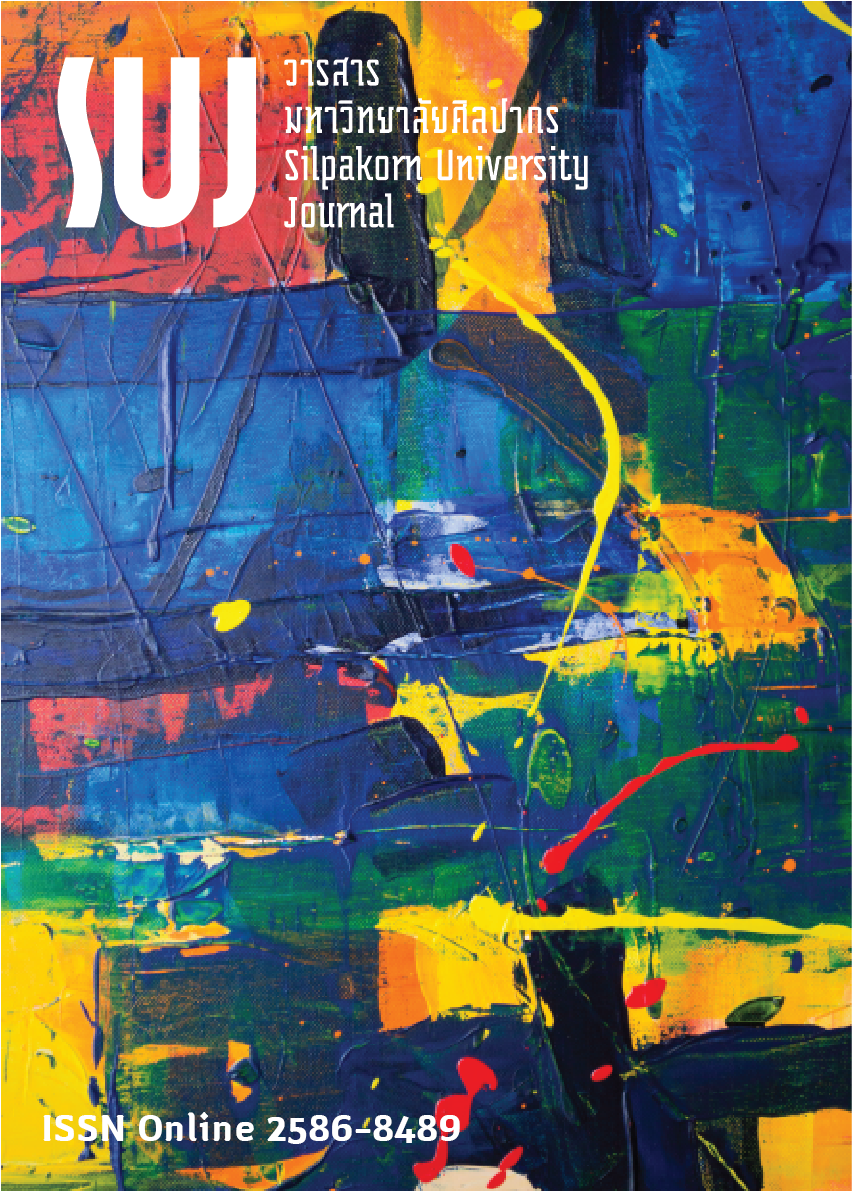พื้นที่และเวลาใน ลิลิตนิทราชาคริต : ลักษณะและความสำคัญ (Space and time in Lilit Nithra Chakrit : characteristics and its significance)
Main Article Content
Abstract
บทความวิจัยนี้มีวัตถุประสงค์เพื่อศึกษาลักษณะของพื้นที่และเวลา และเพื่อวิเคราะห์ความสำคัญของพื้นที่และเวลาในวรรณคดีเรื่อง ลิลิตนิทราชาคริต บทพระราชนิพนธ์ในพระบาทสมเด็จพระจุลจอมเกล้าเจ้าอยู่หัว โดยใช้แนวคิดพื้นที่ (space) และเวลา (time) ผลการวิจัยพบว่า พื้นที่และเวลาปรากฏ 3 ลักษณะ ลักษณะแรก พื้นที่และเวลาในเรื่องถูกสับเปลี่ยนไปมาอย่างฉับพลัน ลักษณะที่สอง ในพื้นที่สำคัญของเรื่องมีการช่วงชิงอำนาจผ่านการปรากฏตัวกับการซ่อนตัว ลักษณะสุดท้าย พื้นที่และเวลาเดิมในเรื่องมีการปรากฏซ้ำ ลักษณะทั้งหมดนี้นับว่ามีความสำคัญต่อการดำเนินเรื่องและการเสนอแนวคิดในลิลิตนิทราชาคริต 3 ประการ ประการแรก พื้นที่และเวลามีความสำคัญในนำเสนอแนวคิดความหลงใหลกับการตื่นรู้ โดยอาศัยพื้นที่ซึ่งมีลักษณะแตกต่างและเวลาที่เปลี่ยนแปลงอย่างฉับพลันเข้ามาใช้ควบคู่กับการปรากฏซ้ำ ประการถัดมา พื้นที่และเวลาของเรื่องยังเชื่อมโยงกับอัตลักษณ์และปฏิสัมพันธ์ของตัวละคร การเปลี่ยนแปลงพื้นที่และเวลา การปรากฏและซ่อนตัวได้ส่งผลต่ออัตลักษณ์ของตัวละครและสร้างความสัมพันธ์เชิงอำนาจของตัวละครหลายชุด ประการสุดท้าย พื้นที่และเวลานับเป็นเครื่องมือสร้างความขบขันผ่านการสับเปลี่ยนพื้นที่และเวลา พร้อมกับการปรากฏตัวและซ่อนตัว อันทำให้เห็นพฤติกรรมที่น่าขบขันจากความไม่เข้ากันและความเหนือกว่าของตัวละครแต่ละฝ่าย เพื่อเน้นย้ำแนวคิดเรื่องการตื่นรู้ให้ชัดเจน
This research article aims to study the characteristics of space and time and to analyze its significance in King Chulalongkorns’s Lilit Nithra Chakrit, a Thai literary version of “The Sleeper Awaken” derived from Arabian Night Entertainment, through space and time frameworks. The results show that three dominant characteristics were found. Firstly, space and time were differently and abruptly shifted. Secondly, there were important roles of presence and concealment in varied spaces. Recurrence of two characteristics mentioned earlier was finally demonstrated. These kinds of space and time then lead to three main essential narrated techniques together with presented themes. To begin with, the theme of a shifted space in a sudden time which repeatedly happened was a key role to present the main theme dealing with obsession and awareness. Regarding the identity aspect, the change and the play with presence and concealment in space and time were also related to identifying characters and their power relationship. Lastly, a sense of humour was constructed by space and time expressing an incongruous situation and a superior sense to make fun of characters before highlighting the theme of awareness.
Downloads
Article Details

This work is licensed under a Creative Commons Attribution-NonCommercial-NoDerivatives 4.0 International License.
References
Amorntrakul, Chonlatep. (2015). Reading “the Politics of Lies” in King Rama V’s Lilit Nitra Chakrit (อ่าน “การเมืองเรื่องโกหก” ในลิลิตนิทราชาคริต พระราชนิพนธ์ในพระบาทสมเด็จพระจุลจอมเกล้าเจ้าอยู่หัว). Journal of Thai Language and Literature, 32(1): 100-126.
Amratisha, Klairung. (2003). Humour in King Chulalongkorn’s Parody Works (อารมณ์ขันในพระราชนิพนธ์ประเภทล้อเลียน). In Piyarachakavin (ปิยราชกวินทร์), (pp. 131-147). Bangkok: Faculty of Arts, Chulalongkorn University.
Baker, C., & Phongpaichit, Pasuk. (2014). A History of Thailand (ประวัติศาสตร์ไทยร่วมสมัย). Bangkok: Matichon.
Barker, C., & Emma. J. (2016). Cultural Studies: Theory and Practice (5th ed.). London: Sage.
Boonhok, Saranpat. (2019). The Overlapping Ideas of ‘Home’ and ‘Nation’: Charateristics and Importance of Home Space in Huajai-Nakrob (The Heart of Warrior) (เมื่อบ้านทับซ้อนกับบ้านเมือง: ลักษณะและความสำคัญของพื้นที่บ้านในบทละครพูดเรื่อง หัวใจนักรบ). In Proceedings of 40th Anniversary of Liberal Arts, Sukhothai Thammathirat Open University (Quality, Equality and Diversity in the Liberal Arts), (pp.172-181). Nonthaburi: School of Liberal Arts, Sukhothai Thammathirat Open University.
Burakasikorn, Wattana. (1970). Lilit Nithra Chakhrit, King Rama V’s Work, and The English Versions of The Story of Abou Hassan, in The Arabian Nights Entertainments: A Comparative Study (ลิลิตนิทราชาคริต พระราชนิพนธ์ในรัชกาลที่ 5 เปรียบเทียบกับ เรื่องอาบูหะซันในนิยายอาหรับราตรี ฉบับภาษาอังกฤษ). Master’s dissertation, Chulalongkorn University, Bangkok, Thailand.
Charoensin-o-larn, Chairat. (2017). Development Discourse: Power, Knowledge, Truth, Identity, and Otherness (วาทกรรมการพัฒนา : อำนาจ ความรู้ ความจริง เอกลักษณ์ และความเป็นอื่น) (6th ed.). Bangkok: Vibhasa.
Chongstitvatana, Suchitra. (2003). A Study of King Chulalongkorn’s Works as A Didactic Literature (การศึกษาพระราชนิพนธ์ในฐานะวรรณคดีคำสอน). In Piyarachakavin (ปิยราชกวินทร์), (pp. 23-40). Bangkok: Faculty of Arts, Chulalongkorn University.
Chotiudompant, Suradech. (2016). Reading City and Story of Bangkok People: Literature, Relationship and Representation of Space (อ่านเมือง เรื่องคนกรุง : วรรณกรรม วิถีความสัมพันธ์ และภาพแทนของพื้นที่). Bangkok: Faculty of Arts, Chulalongkorn University.
Chotiudompant, Suradech. (2019). The Spatial Turn: Methodologies of Spatial Study in Literature (The Spatial Turn: วิธีวิทยาการศึกษาพื้นที่ในวรรณกรรม). In Suradet Chote-Udomphan (Ed.), New Turn: Contemporary Methodologies to Study Literature (นววิถี: วิธีวิทยาร่วมสมัยในการศึกษาวรรณกรรม), (pp. 120-181). Bangkok: Siam.
Chunlawong, Saowanit. (2018). Literary Studies: From Surface to Structure and Ideology (วรรณคดีศึกษา : จากพื้นผิว ถึงโครงสร้าง สู่อุดมการณ์). Nonthaburi: Parbpim.
Kaewthep, Kanjana. (2014). Science of Media and Cultural Studies (ศาสตร์แห่งสื่อและวัฒนธรรมศึกษา) (3rd ed.). Bangkok: Parbpim.
Keeranan, Arada. (2003). King Chulalongkorn’s Remarkable Talents in Performance Literature (พระอัจริยภาพทางด้านวรรณคดีการแสดงในพระราชนิพนธ์). In Piyarachakavin (ปิยราชกวินทร์), (pp. 97-113). Bangkok: Faculty of Arts, Chulalongkorn University.
Khemakhunasai, Pornpan. (2006-2007). Space and Power: Representation from Dek Choa Lay and Klang Thaley Luk. (พื้นที่กับอำนาจ : ภาพแทนความจริงจากวรรณกรรม เด็กชายชาวเล” และ “กลางทะเลลึก”). Parichart Journal, 19(2): 88-102.
King Chulalongkorn. (2009). Lilit Nithra Chakit (ลิลิตนิทราชาคริต). Bangkok: Bannakij.
Kittimahachareon, Saharot. (2017). Contemporary Literature (วรรณกรรมปัจจุบัน). Bangkok: Ramkhamhang University Press.
Nimmanhemin, Prakong. (2008). Folktale Studies (นิทานพื้นบ้านศึกษา) (3rd ed.). Bangkok: Faculty of Arts, Chulalongkorn University.
Padamalangula, Namphueng. (2017). Dream and Imagination in Ramphanphilap: Sunthon Phu and A Construction of “Narrative” in Nirat (ความฝันและจินตนาการในรำพันพิลาป: สุนทรภู่กับการประกอบสร้าง “เรื่องเล่า” ในวรรณคดีนิราศ). Silpakorn University Journal, 37(3): 203-227.
Panyagaew, Wasan. (2017). Introduction to Cultural Studies (วัฒนธรรมศึกษาเบื้องต้น). Chiang Mai: Faculty of Social Science, Chiang Mai University.
Phakdeephasook, Siriporn. (2018). Relationship between Language and Identity and Approachs to Study Thai Language (ความสัมพันธ์ระหว่างภาษากับอัตลักษณ์และแนวทางการนำมาศึกษาภาษาไทย). Bangkok: Faculty of Arts, Chulalongkorn University.
Polmuk, Chairat. (2011). Wong Devaraj: A Comedy at the Dawn of Multicultural Period (วงศ์เทวราช : สุขนาฏกรรม ณ รุ่งอรุณแห่งยุคพหุวัฒนธรรม). In Natthanai Prasannam (Ed.), Humanities in New Decade: Dynamics of Knowledge and Multiculturalism (มนุษยศาสตร์ในทศวรรษใหม่ : พลวัตแห่งองค์ความรู้กับพหุลักษณ์ทางวัฒนธรรม), (pp. 225-240). Bangkok: Faculty of Humanities, Kasetsart University.
Prasarnnam, Nattanai & Rungtheere, Theera. (2014). Crossing the Crossing Bridge : A Compilation of Abstracts and Bibliography of Research on Contemporary Thai Literature (เพื่อก้าวข้ามสะพานที่พาดข้าม : การศึกษารวบรวมบทคัดย่อและบรรณานุกรมงานวิจัยด้านวรรณกรรมไทยร่วมสมัย). Bangkok: Kasetsart University and Ministry of Culture.
Pupaka, Anchalee. (2010). The Works of King Chulalongkorn and King Vajiravudh : Literature and Nation-Building (พระราชนิพนธ์ในพระบาทสมเด็จพระจุลจอมเกล้าเจ้าอยู่หัวและพระบาทสมเด็จพระมงกุฎเกล้าเจ้าอยู่หัว : วรรณคดีกับการสร้างชาติ). Doctoral dissertation, Chulalongkorn University, Bangkok, Thailand.
Ruengruglikit, Cholada. (2009). Phra Ratchaniphon Bot Rabam Talok of King Rama V: The Parody of Conventional Thai Group Dance Performance and of Thai Beliefs (พระราชนิพนธ์บทระบำตลกของพระบาทสมเด็จพระจุลจอมเกล้าเจ้าอยู่หัว : บทระบำที่ทรงเล่นล้อกับขนบการแสดงระบำและความเชื่อของคนไทย). Journal of Royal Society, 34(2): 402-427.
Ruengruglikit, Cholada. (2015). Wannawichai: A Research Monograph of Selective Ayutthaya and Rattanakosin Literatures. (วรรณวิจัย : รวมบทความวิจัยวรรณคดีอยุธยาและรัตนโกสินทร์บางเรื่อง) (2nd ed.). Bangkok: Faculty of Arts, Chulalongkorn University.
Sabaiwan, Wasawat. (2014). World View of Time in Nirat Literature (โลกทัศน์ทางเวลาในวรรณกรรมนิราศ). In Teetat Pasa Wannakarm Wattanatam Karnsuesarn : Selective Papers from National Conference. (ทีทรรศน์ภาษา วรรณกรรม วัฒนธรรม การสื่อสารในโลกยุคเปลี่ยนผ่าน : บทความคัดสรรในการประชุมวิชาการระดับชาติ), (pp. 245-276). Bangkok: Mahidol University and The University of the Thai Chamber of Commerce.
Sajjapun, Ruenruthai. (2016). Influences of Foreign Literary Works on Thai Literature (อิทธิพลวรรณกรรมต่างประเทศที่มีต่อวรรณกรรมไทย) (13th ed.). Bangkok: Ramkhamhang University Press.
Sangkhapantanon, Thanya. (2013). Ecocriticism in Thai literature (วรรณคดีสีเขียว : กระบวนทัศน์และวาทกรรมธรรมชาติในวรรณคดีไทย). Bangkok: Nakorn.
Udomsilpa, Warunee. (2016). Space of Femeinis in Story of Jan Dara (พื้นที่แห่งอิตถีเพศในเรื่องของจัน ดารา). In Suwanna Sta-anan, & Suradech Chotiudompant (Eds.), A Decade of Thai Humanities Research Forum (หนึ่งทศวรรษเวทีวิจัยมนุษยศาสตร์ไทย : แว่นตา อารมณ์ สังคมความจริง). Bangkok: Thailand Research Forum.
Yanprateep, Taweesak. (1978). King Chulalongkorn’s Literary Works (วรรณกรรมพระบาทสมเด็จพระจุลจอมเกล้าฯ). Bangkok: Ramkhamhang University Press.


